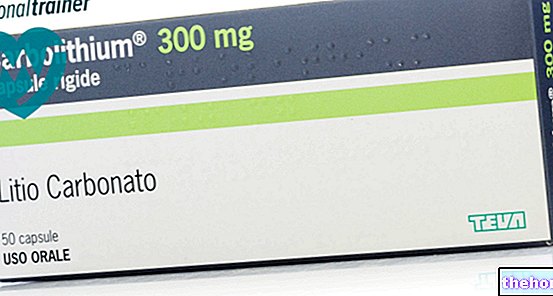Active ingredients: Dequalinium chloride
Fluomizin 10 mg vaginal tablets
Indications Why is Fluomizin used? What is it for?
Dequalinium chloride, the active ingredient of Fluomizin, belongs to the family of anti-infective and antiseptic drugs.
Dequalinium chloride is active against the bacteria that cause bacterial vaginosis.
Fluomizin is indicated for the treatment of bacterial vaginosis.
It is inserted inside the vagina for treatment at the site of infection.
Contraindications When Fluomizin should not be used
Do not use Fluomizin:
- if you are allergic to the active substance dequalinium chloride or to any of the other ingredients of this medicine (listed in section 6).
- if you have ulceration of the vagina or of the cervix;
- if you have not had your first period yet.
Precautions for use What you need to know before taking Fluomizin
The use of soaps, spermicides or vaginal douches (douches) is not recommended during treatment with Fluomizin.
As with all vaginal infections, it is advised to avoid unprotected sexual intercourse while taking Fluomizin.
Fluomizin does not reduce the effectiveness of latex condoms.
This product may reduce the effectiveness of condoms made from materials other than latex or diaphragms. Consequently, you should use alternative precautions for at least 12 hours after treatment.
Do not use Fluomizin in the 12 hours immediately before delivery to minimize the exposure of the newborn to dequalinium chloride. If not, tell your doctor.
You must stop the treatment on the days with the heaviest flow during the menstrual period, and resume it later.
Talk to your doctor if symptoms persist at the end of treatment or if they come back
Interactions Which drugs or foods can modify the effect of Fluomizin
Tell your doctor or pharmacist if you are taking, have recently taken or might take any other medicines, including medicines obtained without a prescription.
Warnings It is important to know that:
Pregnancy and breastfeeding
If you are pregnant, think you may be pregnant or are planning to have a baby, ask your doctor or pharmacist for advice before using Fluomizin. Talk to your doctor or pharmacist if you are breast-feeding or planning to breast-feed.
Based on previous experience and since Fluomizin acts locally, no harmful effects on pregnancy and / or on the fetus and breast-fed infant are foreseeable. Fluomizin should be used during pregnancy and lactation only if medically necessary.
Ask your doctor or pharmacist for advice before taking any medicine.
Driving and using machines
Fluomizin is unlikely to affect your ability to drive or use machines. No studies have been carried out in this regard.
Dose, Method and Time of Administration How to use Fluomizin: Posology
Always use Fluomizin exactly as your doctor has told you. If in doubt, consult your doctor or pharmacist.
The recommended dose is 1 vaginal tablet per day for 6 days.
Instructions for Use
- Use the medicine every night before bedtime. Wash your hands before opening the blister.
- Lie on your back in a reclined position with your legs slightly bent. Insert a vaginal tablet deep into the vagina.
- You should stop the treatment on the days with the heaviest flow during menstruation and resume it later.
- Do not stop the treatment too soon, even if the symptoms have disappeared (e.g. itching, discharge, unpleasant odor). Treatment lasting less than 6 days can cause a relapse.
- Fluomizin contains excipients which do not dissolve completely and tablet residues may occasionally remain on the underwear. This effect has no importance for the effectiveness of the treatment. The tablet does not stain underwear, however, for safety, you can use a sanitary napkin or panty liner.
- In case of excessive dryness of the vagina, it is possible that the vaginal tablet does not dissolve, and that it is expelled intact. This condition involves the non-optimal outcome of the treatment. In this case it is possible to moisten the vaginal tablet with a drop of water before introducing it into the vagina.
If you have the impression that the effect of Fluomizin is too strong or too weak, ask your doctor or pharmacist for advice.
Overdose What to do if you have taken an overdose of Fluomizin
If you use more Fluomizin than you should
Using a higher daily dose or prolonging treatment may increase the risk of vaginal mucosal ulceration.
If you have inadvertently used too many vaginal tablets, contact your doctor.
If you forget to use Fluomizin
Do not take a double dose to make up for a forgotten tablet.
If you stop using Fluomizin
Treatment lasting less than 6 days can cause a relapse. Therefore, do not stop treatment too soon, even if the symptoms (e.g. itching, discharge, unpleasant odor) have disappeared.
If you have any further questions on the use of Fluomizin, ask your doctor or pharmacist.
Side Effects What are the side effects of Fluomizin
Like all medicines, Fluomizin can cause side effects, although not everybody gets them. Most of these side effects are mild and of short duration.
Sometimes the symptoms of vaginal infections (such as itching, burning and discharge) may get worse at the start of treatment, before you start to get better. You should continue treatment, but if the symptoms persist, ask your doctor for advice as soon as possible.
Common side effects (may affect up to 1 in 10 people)
- Vaginal discharge; vaginal itching or burning;
- Vaginal yeast infection (candida)
Uncommon side effects (may affect up to 1 in 100 people)
- Ulceration of the vaginal mucosa, if the vaginal epithelium was already damaged before treatment;
- Vaginal bleeding; vaginal pain; redness, vaginal dryness
- Inflammation of the vagina (vaginitis) or bladder (cystitis)
- Headache
- Nausea;
- Fever;
- Allergic reaction
Reporting of side effects
If you get any side effects, talk to your doctor. This includes any possible side effects not listed in this leaflet. Side effects can also be reported directly through the national reporting system, at the address https://www.aifa.gov.it/content/segnalazioni-reazioni-avverse
By reporting side effects you can help provide more information on the safety of this medicine.
Expiry and Retention
Keep this medicine out of the sight and reach of children.
Do not use Fluomizin after the expiry date which is stated on the carton and blister. The expiry date refers to the last day of the month.
This medicine does not require any special storage conditions.
Do not throw any medicines via wastewater or household waste. Ask your pharmacist how to throw away medicines you no longer use. This will help protect the environment.
What Fluomizin contains
The active ingredient is dequalinium chloride.
Each vaginal tablet contains 10 mg of dequalinium chloride.
The other ingredients are lactose monohydrate, microcrystalline cellulose, and magnesium stearate.
What Fluomizin looks like and contents of the pack
Fluomizin vaginal tablets are white or off-white in color, and oval and biconvex in shape with an approximate size of 19mm in length, 12mm in width and 6.3mm in thickness. The vaginal tablets are available in packs containing a blister of 6 tablets.
Source Package Leaflet: AIFA (Italian Medicines Agency). Content published in January 2016. The information present may not be up-to-date.
To have access to the most up-to-date version, it is advisable to access the AIFA (Italian Medicines Agency) website. Disclaimer and useful information.
01.0 NAME OF THE MEDICINAL PRODUCT
FLUOMIZIN 10 MG VAGINAL TABLETS
02.0 QUALITATIVE AND QUANTITATIVE COMPOSITION
Each tablet contains 10 mg of dequalinium chloride.
For the full list of excipients, see section 6.1.
03.0 PHARMACEUTICAL FORM
Vaginal tablets.
Vaginal tablets are white or almost white, oval and biconvex.
04.0 CLINICAL INFORMATION
04.1 Therapeutic indications
Fluomizin 10 mg vaginal tablets are indicated for the treatment of bacterial vaginosis (see section 4.4).
Official guidelines relating to the appropriate use of antibacterial agents should be kept in mind.
04.2 Posology and method of administration
Method of administration: vaginal use.
One vaginal tablet a day for six days.
The vaginal tablets are inserted deep into the vagina in the evening before bedtime. For best results, perform this operation in the supine position, bending the legs slightly.
Treatment should be interrupted during menstruation and resumed at the end of the same.
Although a reduction in secretion and inflammation is usually felt within 24-72 hours, the treatment should be continued even in case of disappearance of subjective discomforts (itching, discharge, unpleasant odor). A treatment of less than six days can cause a relapse.
For use in women below 18 years of age and above 55 years, see section 4.4.
04.3 Contraindications
Hypersensitivity to the active substance or to any of the excipients;
Ulcer of the vaginal epithelium and of the vaginal portion of the uterine cervix;
Young girls who have not yet had their first menstruation, and therefore have not yet reached sexual maturity, should not use Fluomizin.
04.4 Special warnings and appropriate precautions for use
To minimize infant exposure to dequalinium chloride, vaginal tablets should not be used within 12 hours prior to delivery.
There are no data on efficacy and safety regarding resumption of treatment in patients who have failed to respond to therapy or who have relapsed immediately after initial Fluomizin therapy. Use of higher daily doses, or prolongation of the recommended duration treatment may increase the risk of vaginal ulceration.
There are no data on efficacy and safety related to the treatment of bacterial vaginosis in women under the age of 18, or over the age of 55.
04.5 Interactions with other medicinal products and other forms of interaction
Anionic substances such as soaps, detergents and surfactants can reduce the antimicrobial activity of dequalinium chloride. Therefore, the simultaneous intravaginal use of soaps, spermicides or vaginal douching is not recommended.
Fluomizin 10 mg vaginal tablets does not affect the functionality of latex condoms. There are no data relating to the interaction with condoms made of material other than latex and with other intravaginal devices, such as the diaphragm. Therefore, the concomitant use of condoms made of material other than latex and other intravaginal devices is not recommended.
04.6 Pregnancy and lactation
Pregnancy:
Four clinical studies, conducted on 181 pregnant women, indicate no adverse effects on pregnancy, or on the health of the fetus / newborn. Furthermore, the considerable experience following the placing on the market of the product indicates the absence of malformations or fetal / neonatal toxicity of Fluomizin.
Animal reproductive toxicity studies have not been conducted due to the expected low systemic exposure to dequalinium chloride following its vaginal administration.
The use of Fluomizin during pregnancy may be considered if necessary.
Feeding time:
Systemic exposure to Fluomizin by breastfeeding women is negligible. Therefore, no harmful effects on the breastfed infant / child are expected.
If clinically necessary, Fluomizin can be used during lactation.
To minimize infant exposure to dequalinium chloride, vaginal tablets should not be used for 12 hours prior to delivery.
04.7 Effects on ability to drive and use machines
No studies on the ability to drive and use machines have been performed.
04.8 Undesirable effects
In clinical studies, the following undesirable effects possibly, or probably related to dequalinium chloride, were reported.
Within each frequency class, undesirable effects are reported in descending order of severity.
During the post-marketing experience the following undesirable effects have been reported (frequency not known):
- Reproductive system and breast disorders: ulcer and maceration of the vaginal epithelium, uterine haemorrhage, redness, vaginal dryness
- Infections and infestations: cystitis
- General disorders and administration site conditions: fever, allergic reactions
04.9 Overdose
No cases of overdose have been reported. However, the use of higher daily doses can cause vaginal ulcers.
05.0 PHARMACOLOGICAL PROPERTIES
05.1 Pharmacodynamic properties
Pharmacotherapeutic group: Anti-infectious and antiseptic for gynecological use. Quinolone derivatives. ATC code: G01AC05.
Dequalinium chloride is an anti-infective and antiseptic agent belonging to the class of quaternary ammonium compounds.
Mechanism of action:
Dequalinium chloride is a surfactant substance. The main mode of action consists in the increase of the permeability of bacterial cells and the subsequent loss of enzymatic activity; the end result is the death of the cells themselves.
Dequalinium chloride has a rapid bactericidal activity.
The dequalinium chloride in vaginal tablets exerts its action locally inside the vagina.
PK / PD relationship:
No PD / PK parameter that discriminates for efficacy has been defined for Fluomizin. Since the bactericidal effect of dequalinium chloride occurs within 30-60 minutes, the maximum local concentration obtained within the first hour after application is considered crucial for purposes of effectiveness.
Resistance mechanism (s):
The mechanisms that determine the inherent resistance of some pathogens are not known. No development of acquired resistance has been observed to date.
Breakpoints:
There are no breakpoints for dequalinium chloride indicated by an organization competent to issue recommendations and no relationship has been established between the minimal inhibitory concentration and clinical efficacy. Therefore, the information relating to susceptibility, reported in the following table, is descriptive and is based on the concentrations that can be obtained within the vagina (see section 5.2) and on the respective MIC data of the pathogens.
The prevalence of acquired resistance may vary geographically and with time for selected species, and therefore local information on resistance is desirable, especially when treating severe infections. As necessary, expert advice should be sought when the local prevalence of resistance is such that the utility of the drug, at least for some types of infections, is questionable.
05.2 "Pharmacokinetic properties
Following dissolution of a vaginal tablet of Fluomizin (10 mg of dequalinium chloride) in a quantity defined by 2.5-5 ml of vaginal fluid, the concentration of dequalinium chloride in the vaginal fluid is equal to 2000 - 4000 mg / l.
Preclinical data indicate that dequalinium chloride is poorly absorbed following vaginal application.
Therefore, systemic exposure to Fluomizin is negligible, and no further pharmacokinetic data are available.
05.3 Preclinical safety data
In view of the negligible systemic exposure to intravaginally administered dequalinium chloride, general toxic effects of Fluomizin are unlikely.
In vivo and in vitro studies performed on dequalinium chloride did not yield any indication of possible mutagenicity.
No toxicological studies have been conducted with dequalinium chloride.
A study in rabbits showed Fluomizin good vaginal tolerance.
06.0 PHARMACEUTICAL INFORMATION
06.1 Excipients
Lactose monohydrate; microcrystalline cellulose (E460a); magnesium stearate (E470b).
06.2 Incompatibility
Fluomizin is incompatible with soaps and other anionic surfactants.
06.3 Period of validity
3 years.
06.4 Special precautions for storage
This medicine does not require any special storage conditions
06.5 Nature of the immediate packaging and contents of the package
PVC / PE / PVdC / aluminum blisters
Packs of 6 vaginal tablets
06.6 Instructions for use and handling
Since Fluomizin contains excipients that do not dissolve completely, tablet residues may occasionally appear in the slip. This effect has no importance for the effectiveness of Fluomizin.
In rare cases of excessive vaginal dryness, the vaginal tablet may not dissolve and may be expelled intact from the vagina. Consequently, the treatment is not optimal. As a preventive measure, in case of excessive vaginal dryness, it is possible to moisten the vaginal tablet with a drop of water before its introduction.
Patients should use a sanitary napkin or panty liner. The product does not produce any alteration in the color of the linen. Patients should be advised of the need to change underwear and towels every day and to wash them at a temperature of at least 80 ° C.
07.0 MARKETING AUTHORIZATION HOLDER
PIERRE FABRE PHARMA S.r.l. - Via G.G. Wickelmann 1 - 20146 Milan
08.0 MARKETING AUTHORIZATION NUMBER
"10 mg vaginal tablets" 6 tablets in PVC / PE / PVDC / Al blister - AIC: 041382019 / M
09.0 DATE OF FIRST AUTHORIZATION OR RENEWAL OF THE AUTHORIZATION
July 2012
10.0 DATE OF REVISION OF THE TEXT
October 2012























-nelle-carni-di-maiale.jpg)




